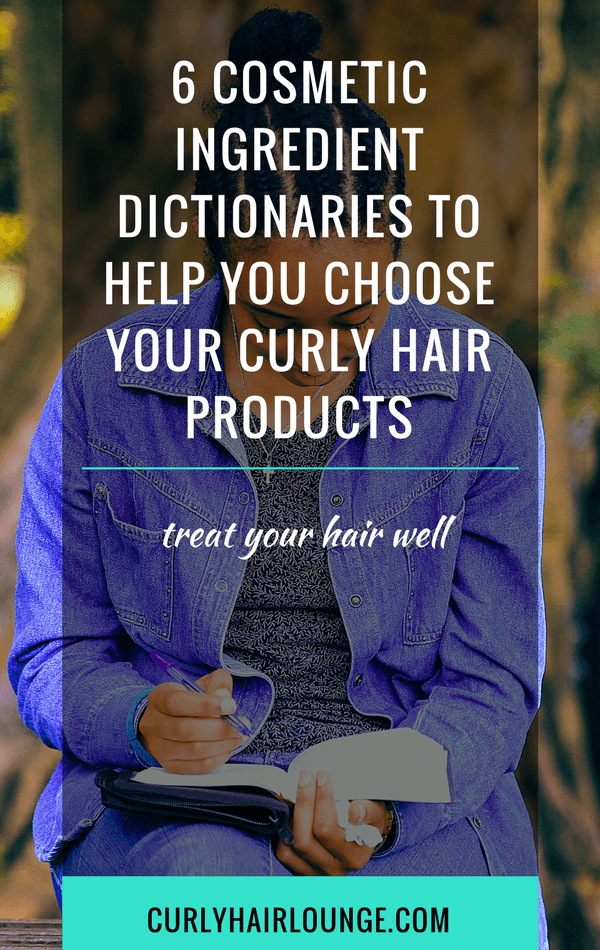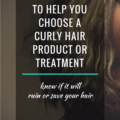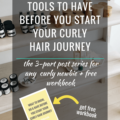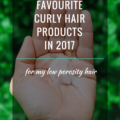If there’s one thing a lot of people in the natural hair community are all too willing to do is to accept and follow hair product advice on their hair woes. It’s very common to read or hear people say “My hair is super___ (fill in the blank) what can I do to fix this?”. Though products can do a lot to lift and rehabilitate your hair’s health, they’ll work better if you know what’s in them and what they’ll do for your curly hair. One way to get familiar with what’s inside your products is to use a cosmetic ingredient dictionary.
But before I go on to tell you where you can find these there are a few things I need you to understand first. (Thought I was going straight to the point, Nah… You know that’s not me, I always have something more to say, but then again if you’ve been with me for a while you know this… 😉 )
When we follow advice and buy hair products blindly what ends up happening is that we don’t often get the results we expect, sometimes we even end up worse and the product is to blame. There are many reasons for things not working out:
- The product recommended to you wasn’t appropriate to deal with your hair condition
- You used the product incorrectly.
- The product had ingredients that made your hair condition worse.
- The product didn’t have the ingredients your hair needed.
- You don’t have a good hair regimen set in place.
- You use hair tools that undermine the products promised results.
- Your hair is in a much better/worse condition and you need something else.
- etc.
The point is, seeing or chatting with someone on YouTube, Facebook, Instagram or wherever else is new and taking on their advice based on their experience is not gonna do your har any good. What you’re basically doing, is giving you hair something that is not adequate to YOUR hair needs.
This is because there are no two heads of curly hair that are the same, and if there are (which is highly unlikely but let’s assume there are) they probably live in different continents, with different climates, with different water quality and all these have an influence on how products work on our hair.
The Good Hair Care Partnership Formula
Hair care, good hair care that translates into healthy, strong hair is not just a matter of choosing the product that is labelled to fix the hair problem you complain to be suffering about, like hair moisture for instance, or doing what worked for someone else.
Products don’t work alone! Good hair care is a partnership between your understanding the principles of how curly hair works (it’s physiology/structure) + knowing your current hair health + having good hair care practices AND choosing the products that will cater to your hair needs based on their ingredients and how they’ll help you achieve what you’re looking for. Let highlight this partnership so you don’t forget:
Good Hair Care /Healthy Hair = Knowledge of Hair Physiology/Structure + Knowledge Current Hair Health + Good Hair Care Practices + Hair Product
⠀
A bad understanding of any of the principles in this partnership allied to bad, inaccurate or outdated information is what causes hair woes that can sometimes be very dramatic.
If you need to read up more on any part of the Hair Care Partnership Formula I have a few blog posts that can help you do that below. You can come back to them later once you finish reading this post:
Hair Physiology
Transitioning To Natural Hair & Understanding Your Curly Hair
Unboxing Natural Hair – What Is Your Hair Type?
Unboxing Natural Hair – What Is Hair Porosity
Unboxing Natural Hair – What Is Hair Density?
Unboxing Natural Hair – Hair Texture & Elasticity
Unboxing Natural Hair – Connecting The Dots
Hair Health
The 4 Elements Of Knowing How To Moisturise Transitioning Hair
5 Reasons Why You’re Still Struggling With Dry Curly Hair
Good Hair Care Practices
Finally! A Natural Hair Regimen That Works.
3 Mistakes You’re Making When Building Your Natural Hair Care Routine. (3-part post series)
12 Tips On How To Transition To Natural Hair (tips also good if you’re not transitioning. 😉 )
Know Your Deep Conditioner and Jumpstart Your Results
5 Things You Need To Know When Co-Washing Curly Hair
5 Tips It’s Time To Use A Clarifying Shampoos
Hair Product
Natural Hair Products Ingredients – What’s in Them
4 Ingredients That Take Moisture From Your Hair
Natural vs Synthetic Ingredients For Curly Hair Products
Reading Hair Care Product Labels
5 Tips to Help You Choose a Curly Hair Product or Treatment
There’s a lot more on the blog among the nearly 300 posts, feel free to read the ones I am suggesting above, check up on others using the search box or do your own research using a reliable source.
Are you ready to finally move on to business and get to the Cosmetic Ingredients Dictionaries/Sources I normally use to check product ingredients? Bet you are 😉 😀
Cosmetic Ingredient (Online) Dictionary
So the places I am about to share with you are online dictionaries/sources which makes it perfect because you can check if a product is a good buy for your hair while you’re on the go. Just make sure you bookmark the web addresses on your mobile browser for easy access.
#1| CosmeticsInfo.org
This is one of my favourite ingredient dictionaries. It is well organised, you can look up ingredients by ‘Product Category’ such as ‘Fragrance’, ‘Hair Care’ or ‘Hair Dye and Hair Coloring’ or you can simply type in the search box. If you search for a group of ingredients like surfactants it may give a long list of results with 11+ pages to look for. Alternatively, you can type in the exact name of the ingredient, however, if the name is misspelt, wrong or doesn’t match what is in the database you won’t get any results.
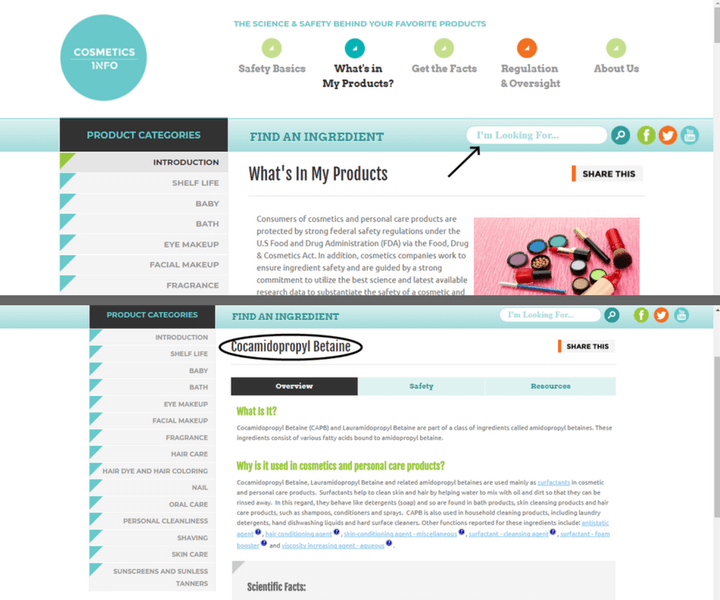
In this case, I prefer typing the name of the ingredients in my browser and look for the CosmeticsInfo in the search results. I know it kinda defeats the purpose of going directly to the source, but they’re worth this little hassle.
In addition to this, when you get a result for your ingredient search you also get safety information and further resources to look up. Great, right?!
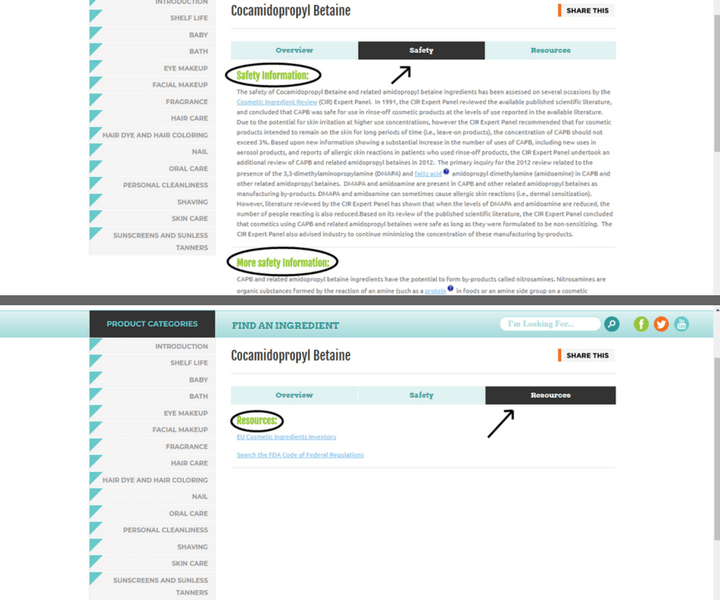
#2| EWG.ORG – Environmental Working Group
This one you may already know, as it comes up a lot in search engines. It is actually the first one I used when I started my hair journey. It is an organisation that aims to provide the consumer with information about everyday exposure to chemicals with cosmetics, cleaning products, produce, etc.
They created Skin Deep, which, according to them, creates “online profiles for cosmetics and personal care products and their potential hazards and health concerns”. You can use the menu option ‘Hair’ to look for a specific product category like shampoo, which then pulls up all shampoos in the database. You can also use the big search box on the homepage to type a brand’s name (which will give you all their products in the database) or the exact name of the product.
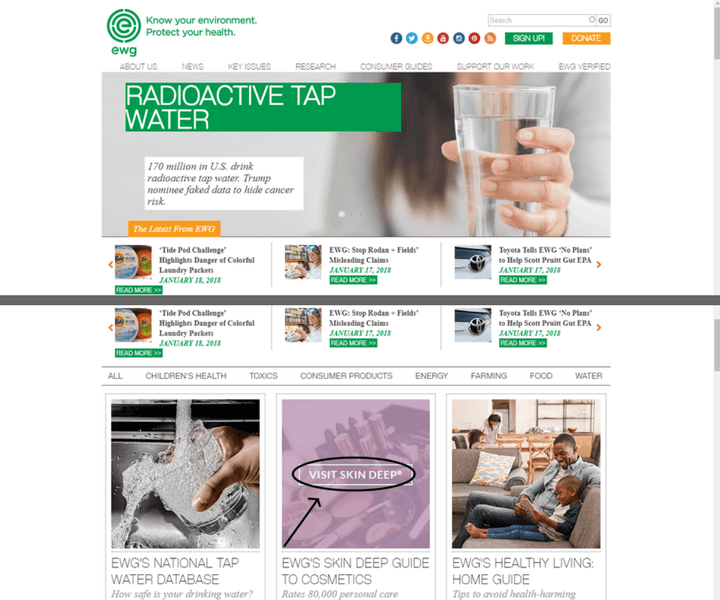
In this case, you select your product and it will pull up a ‘file’ with a hazard score key (see below) with all the ingredients and their individual hazard score. You can then click on the ingredient to get more information. Alternatively, you can also type the ingredient name on the search box.
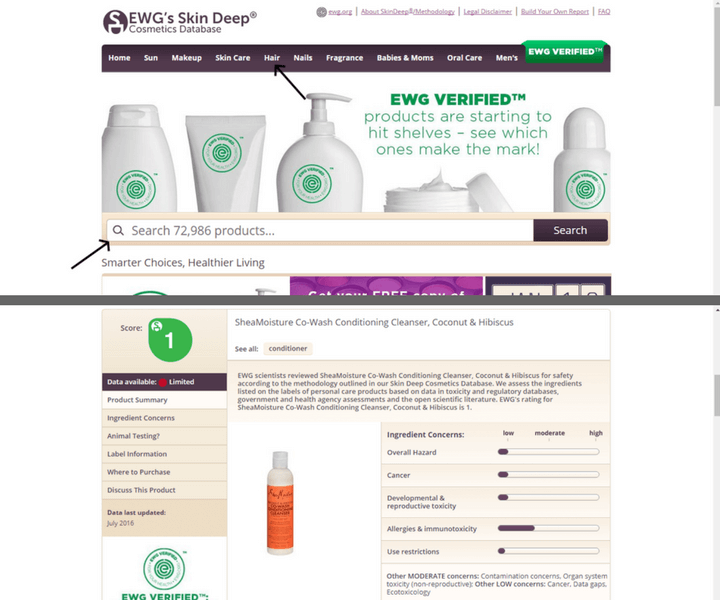
This site is good if you’re worried about exposure to chemical and you want to avoid ingredients that are said t be allergenic, carcinogenic or otherwise. It also gives you a brief description of the ingredients, it’s function and it’s synonyms. Interesting this last one, right!?
Oh, and if you want you can download the EWG Skin Deep App into your mobile. This way you can scan a product and it will show you information on it.
#3| TightlyCurly.Com
This is a hair product ingredient dictionary created by a curly girl who spent years struggling to manage her hair and never got the help she desperately needed from professional or books. She then started doing her own research and developed this website to help other curlies.
There’s an extensive ingredient dictionary with personal notes about Teri’s experience with that ingredient in a product or her thoughts on it. She rates the ingredients in 4 different categories: Good, Okay, Caution and Avoid. The only downside here is that there s no search box to make you ingredient research easier. You have to look for it alphabetically.
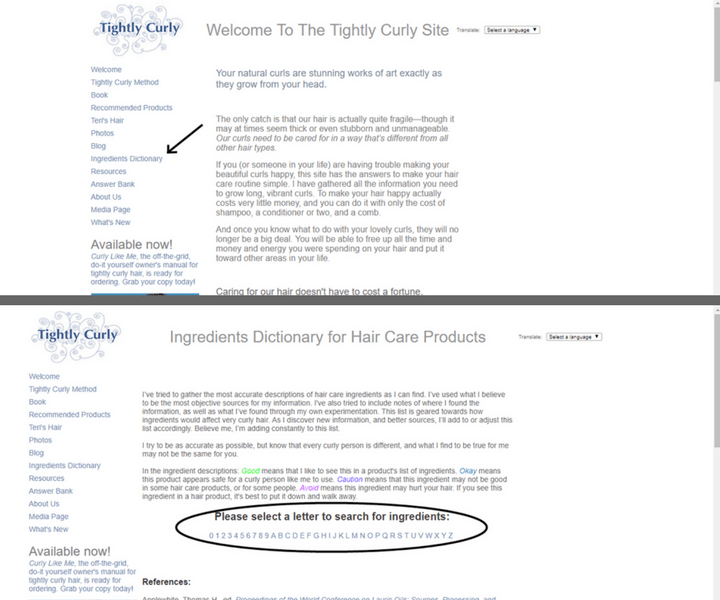
All and all, Tightly Curly a breath of fresh air from the more scientific oriented dictionaries/sources. She explains things in a language we can all understand and know.
#4| NCBI – PubMed
NCBI stands for National Center for Biotechnology Information, it conducts research and gathers and analyzes research information on molecular biology, biochemistry, and genetics. I use NCBI not so much because it is an ingredient dictionary – it’s not – but because I can find hair related research which an ingredient is a part of.
Though studies have a brief description of the ingredient and its use, in NCBI I am looking for side effects, allergies, how it’s best used in a formula… You get it, don’t you? Yeah, am a bit of a nerd when it comes to natural hair. 😉
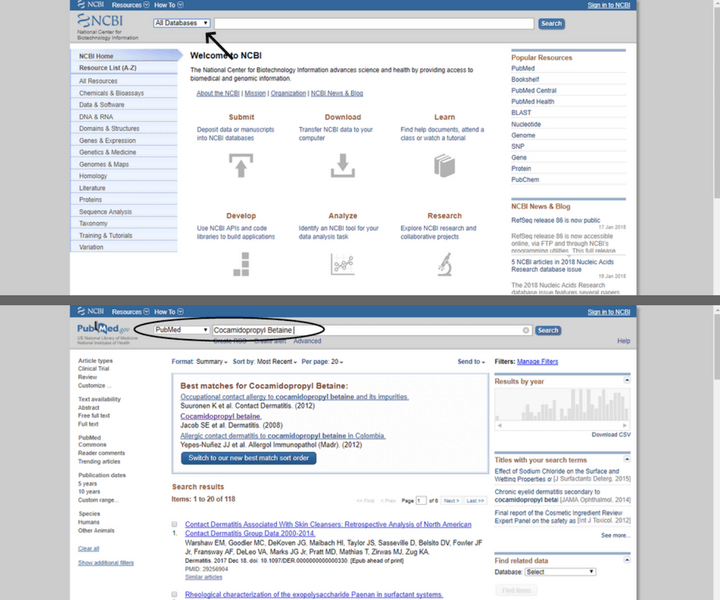
Anyway, when you land on NCBI it is best to choose the database you wish to pull out the information you’re looking for. I like using PubMed from the drop-down list at the top (though there is also PubMed Substance, Compound, Health and others. Ignore them.). Then I type what I’m looking for and select the study that interests me most. See below.
#5| Google Scholar
Yeah, you guessed it I’m a bit of a nerd when it comes to natural hair. Google Scholar is a tool I learn to use when I was University studying Psychology & Counselling and I haven’t stopped yet. It let you search for scholarly literature across different disciplines and sources like articles, theses, studies, books, study abstracts, academic publishers or universities.
Sometimes you don’t find anything relevant to what you’re looking for but other times you find little jewels of knowledge. On my computer, I have a Google Scholar Button on my web browser for easy access.

There’s no difficulty using it, I pretty much use it in the same way as I use Google.
#6| TruthInAging
Much like Teri in Tightly Curly, Truth In Aging was founded by Marta who was tired of having a bathroom full of skin products that promised to do a lot and did too little. She began her research to find which anti-ageing ingredients worked, which didn’t and why.
This website gives reviews on beauty products and it is in the process of doing this that all ingredients are scrutinised and researched, which lead to the creation of a directory of over 3,140 ingredients.

It’s a directory that is easy to use and when I use it I always compare and contrast against science-based sources (like the previously mentioned in this post). But don’t worry, most of the time they’re both in agreement.
I hope these product ingredient dictionaries help you as much as they help me in knowing your products better and how they can fit into a hair routine that helps your curly hair thrive. Don’t forget to read up on the posts for the Hair Care Partnership Formula.

